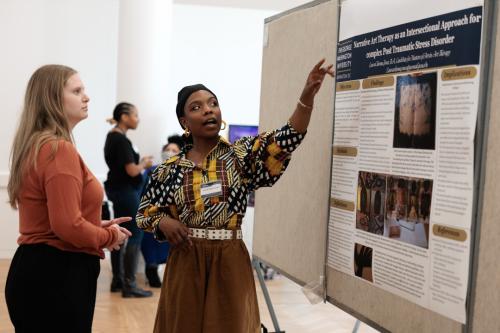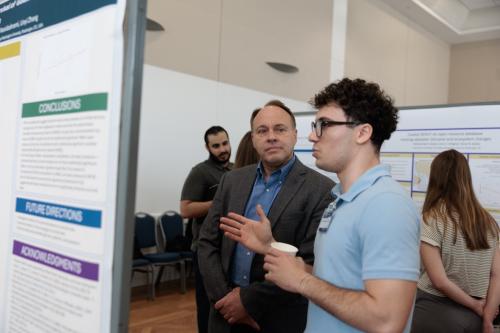From studying wild chimpanzees in Tanzania to examining food security in Central America, from improving the forensic science of drug analysis to uncovering the economic roots of happiness, an array of graduate and undergraduate student research was on display at the third annual Columbian College of Arts and Sciences (CCAS) Research Showcase on April 2 at the George Washington University Student Center.
More than 200 students—a 40 percent increase from last year’s showcase—presented posters from research projects across 31 CCAS disciplines. Their work covered a gamut of topics including the historical struggle to ratify the U.S. Constitution, the complex role of proteins in wound-healing and the secret government strategy to shift public opinion on nuclear energy.
Nearly 500 visitors were in attendance, including GW President Ellen M. Granberg, CCAS Dean Paul Wahlbeck, faculty research mentors and fellow classmates.
“These projects speak to the extraordinary breadth and depth of research happening across our college,” Wahlbeck said. “From the sciences to the social sciences, arts and humanities, this work reflects our commitment to fostering a rich, interdisciplinary learning environment.”

Professor of Physics Evangeline J. Downie, CCAS associate dean of research and strategic initiatives, highlighted the growing student participation in the event over the past three years and applauded the CCAS community for supporting student scholars.
“Moments like this give us a chance to reflect on the great impact that our research has, not only on the students and postdocs who engage in it as they grow their skill sets, but also on the outside world,” she said.
For students, the event represented the culmination of months—even years—of data collection and analysis. First-year geography master’s student Emma Haggerty spent several summers taking permafrost measurements in the Arctic as part of her project on how climate change is affecting northern transportation routes. As a three-time CCAS Showcase presenter—twice as an undergraduate student—Haggerty said the feedback she’s received each year has helped her research evolve.
“I’ve talked to people who know a lot about [the Arctic] and have provided real insight, and I’ve talked to people who know nothing about it but offered important little suggestions like making the lines on my poster darker,” she said. “Everything is helpful for a project like this to keep growing and changing.”

Many of the research presentations reflected students working closely with people throughout the community. LauraChioma Jones, a second-year art therapy master’s student, spent 25 weeks visiting a D.C.-area woman suffering from complex post-traumatic stress disorders. Jones used a narrative approach to the therapy sessions, asking her client to keep a journal of both her positive and negative thoughts. Eventually she literally tore away her self-critical pages. “It gave her the opportunity to rebuild herself and write her own story,” Jones said. In fact, Jones and her client agreed that presenting her research at the showcase was a fitting debut for her new narrative. “This is what she dreams of doing with her experience—sharing it with others,” Jones explained.
Many projects highlighted understudied arts and cultures. Sandra Koretz, a junior majoring in art history and journalism and mass communications, explored a secret society of West African women who wear elaborate masks to represent ideals of feminine beauty. Koretz, who recently received a CCAS Luther Rice Undergraduate Research Fellowship, learned of the Sande Society of Sierra Leone in a class with her faculty mentor Assistant Professor of Art History Clement Akpang. “I fell in love with the Sande story, and I knew that I had to delve deeper,” Koretz said. For her research, she studied an actual Sande mask on display at the CCAS Corcoran School of the Arts and Design.
Dayna Bailey, a second-year graduate student in Chinese language and culture, took on an arduous translation of a palindromic poem by a 5th century female Chinese poet. A 29X29-character grid originally woven into a garment, Su Hui’s “Map of the Armillary Sphere” presents near innumerable readings—horizontally, vertically and diagonally. “Very likely no two people will ever read it in exactly the same way,” Bailey said.
Reaching Across Disciplines
Some students had deep personal connections to their showcase topics. First-year cellular and molecular biology major Christopher Petrarca chose his examination of the wound-healing protein GPR84 partly due to his Dominican family’s higher risk of diabetes. “They struggle with obesity and diabetes. So this [research] hits close to home,” he said.
Similarly, second-year economics graduate students Anmol Purbey and Riya Varghese were drawn to their study of global climate reform strategies because their native countries—Purbey is from Nepal, Varghese from India—are among the hardest hit by environmental vulnerabilities.
Their 182-country database, designed to help policymakers enhance institutional preparedness, determined that targeted interventions are more effective than widespread strategies for reducing emissions. “As economists, this research is very important to us and to our countries back home,” Varghese said.

Senior biology major Mohammad Nawal had his own personal connection to Associate Professor of Biology Keryn Gedan’s research into the environmental deterioration of the Chesapeake Bay. He fondly recalled childhood summers visiting relatives along the waterway’s Virginia outlets. His project examines coastal transition zones—ecosystems where freshwater and saltwater meet—which he described as “patient zero for the pandemic of damaging saltwater intrusion.”
In addition to presenting their own research, students said the highlight of the event was comparing notes with classmates.
Senior history major Marielle Cornes found her presentation on the historical evolution of women in American politics situated between senior Isabella Kumar’s American studies project on art and architecture in Adams Morgan and senior dance major Ana Arledge’s appreciation of choreographer Merce Cunningham. Across disciplines and poster boards, the three undergraduates traded tips and praise.
“Interacting with other researchers is inspirational,” Cornes said. “They can give you new ideas and new ways of seeing things. We all leave here with stronger final products.”


